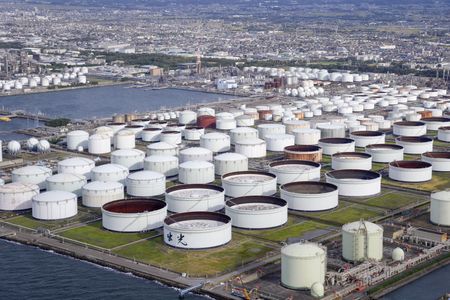
By Laura Sanicola
(Reuters) -Oil prices rose on Tuesday as tight global supply outweighed worries that fuel demand would be hit by a possible recession and fresh COVID-19 curbs in China.
Brent crude futures rose $1.37, or 1.1%, to $123.64 a barrel at 12:20 p.m. EDT (1620 GMT), while U.S. West Texas Intermediate (WTI) crude rose $1.22, or 0.9% to $122.05 a barrel.
Tight supply has been aggravated by a drop in exports from Libya amid a political crisis that has hit output and ports.
Other OPEC+ producers are struggling to meet their production quotas and Russia faces bans on its oil over the war in Ukraine.
The United States will allow certain energy-related transactions with Sberbank, VTB Bank, Alfa-Bank and several other Russian entities to continue through Dec. 5, the U.S. Department of Treasury said in notice posted online on Tuesday.
UBS raised its Brent price forecast to $130 a barrel for end-September and to $125 for the subsequent three quarters, up from $115 previously.
“Low oil inventories, dwindling spare capacity, and the risk of supply growth lagging demand growth over the coming months have prompted us to raise our oil price forecast,” the bank said.
Ratings agency Fitch raised its Brent and WTI price assumptions for 2022 by $5 to $105 and $100 a barrel, respectively.
The market will be awaiting weekly U.S. inventory data from the American Petroleum Institute on Tuesday and the U.S. Energy Information Administration on Wednesday for a view of how tight crude and fuel supply remain.
Six analysts polled by Reuters forecast U.S. crude inventories to have fallen by 1.2 million barrels last week, while gasoline stockpiles rose 800,000 barrels and distillate inventories, which include diesel and heating oil, were unchanged.
On the demand side, China’s latest COVID outbreak traced to a bar in Beijing has raised fears of a new phase of lockdowns just as restrictions in the country were being eased and fuel demand was expected to firm.
In its monthly report, the Organization of the Petroleum Exporting Countries kept to its forecast that world oil demand will exceed pre-pandemic levels in 2022, but said Russia’s invasion of Ukraine and developments related to the coronavirus pandemic pose a considerable risk.
The group, however, sees demand growth slowing next year, OPEC delegates and industry sources told Reuters, as surging oil prices help drive up inflation and act as a drag on the global economy.
Looking ahead, oil prices may face pressure if the U.S. Federal Reserve surprises markets with a higher-than-expected interest rate hike to tame inflation when it meets on June 14-15.
“While a recession is likely…the impact of such a development is apt to be left to a later day with tight product supplies keeping the complex and crack spreads sharply elevated,” said Jim Ritterbusch, president of Ritterbusch and Associates LLC in Galena, Illinois.
(Additional reporting by Ahmad Ghaddar in London, Sonali Paul and Isabel Kua in Singapore; editing by Jason Neely, Louise Heavens, Marguerita Choy and Deepa Babington)

